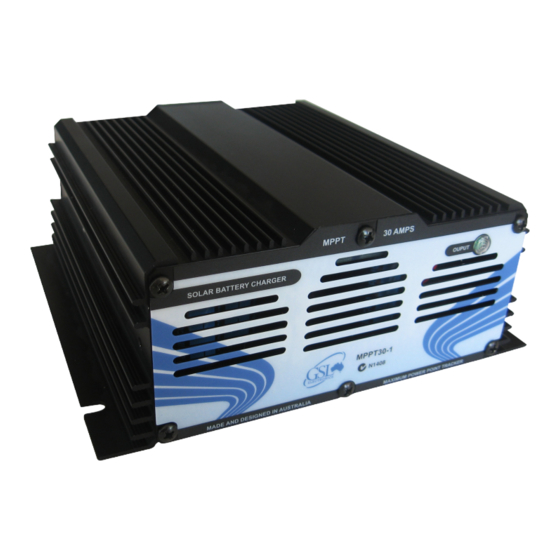Advertisement
Quick Links
Model:
1700W Solar Battery Charger
MPPT30-1
Maximum Power Point Tracker
Page 1 of 8
Operating Instructions
Please read these instructions before use
This revolutionary maximum power point tracker solar charger was
designed using the technology that won GSL Electronics the prestigious
"2008 EDN Innovation award". A simple, compact and low cost
alternative. Ideal for charging batteries with the new low cost and high
efficiency grid type panels.
MPPT30-1 Unit
PATENT APPLIED FOR - 2010901565
MPPT30-1-R5
Unit 2, 1 St James Place, Seven Hills ,NSW, 2147, Australia
Advertisement

Summary of Contents for GSL MPPT30-1
- Page 1 Please read these instructions before use This revolutionary maximum power point tracker solar charger was designed using the technology that won GSL Electronics the prestigious “2008 EDN Innovation award”. A simple, compact and low cost alternative. Ideal for charging batteries with the new low cost and high efficiency grid type panels.
- Page 2 MPPT30-1 Maximum Power Point Tracker Page 2 of 8 Operating Instructions Please read these instructions before use MPPT30-1 Specifications Efficiency typical Input voltage 16V to 95V Float 13.5V / 27V / 54V Absorption – Vented LA batteries 14.5V / 29V / 58V Output voltage –...
-
Page 3: Important Notes
• This equipment must be installed by qualified personnel only and incorrect wiring can cause fire, injury or death – GSL will accept no responsibility for MPPT misconnection or misuse. • Use only sealed or vented 12V, 24V or 48V lead acid batteries and confirm the MPPT settings, charge voltages and currents are correct for your battery system –... - Page 4 Model: 1700W Solar Battery Charger MPPT30-1 Maximum Power Point Tracker Page 4 of 8 Operating Instructions Please read these instructions before use For optimal performance from panel and MPPT please use the following table to determine the best setup for your situation.
- Page 5 Model: 1700W Solar Battery Charger MPPT30-1 Maximum Power Point Tracker Page 5 of 8 Operating Instructions Please read these instructions before use Changing Battery Type Setting Procedure 1.Ensure all the MPPT wires are disconnected. 2.Remove 7 front panel screws and the front panel and slide out cover – see Figure 1.
- Page 6 Model: 1700W Solar Battery Charger MPPT30-1 Maximum Power Point Tracker Page 6 of 8 Operating Instructions Please read these instructions before use Figure 2 (Above): Vented Battery Setting Figure 3 (Above): Sealed Battery Setting MPPT30-1-R5 Unit 2, 1 St James Place, Seven Hills ,NSW, 2147, Australia...
- Page 7 Q: What sorts of loads can I power with the MPPT30? 1.The maximum bulk charge current with the MPPT30-1 on a 12V battery and 400W panel is approximately 30A, so you can expect about 100AH per day which means a 100W load for about 10 hours daily.
- Page 8 Q: Why are MPPT not more common in standalone solar systems? Until now and despite their overwhelming advantages MPPTs have not been commonly used in standalone solar systems because of cost. The new GSL MPPT specifically addresses this issue making economic sense in a wide range of solar systems.






Need help?
Do you have a question about the MPPT30-1 and is the answer not in the manual?
Questions and answers